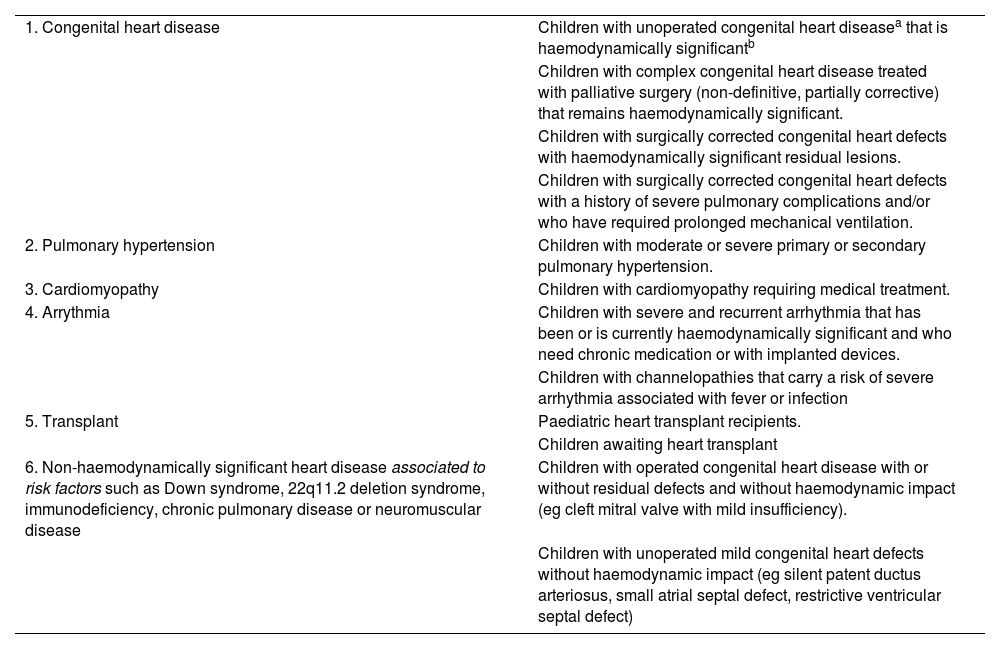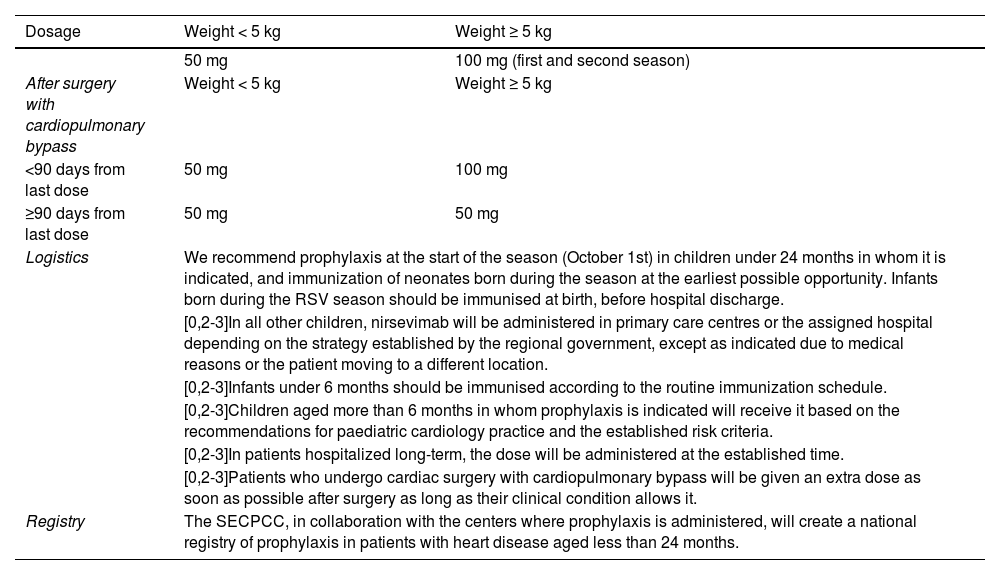Respiratory syncytial virus (RSV) is one of the leading causes of lower respiratory tract infection in children, and is the most common reason for hospital admission in young children.1 In specific risk groups, such as children with congenital heart disease, it can result in an increased rate of hospitalization, morbidity and mortality, delayed surgical intervention and a substantial increase in health care costs.2
Different hygiene measures, such as hand or toy washing, or environmental measures, such as avoiding places or situations where transmission could occur, exposure to tobacco smoke or contact with older siblings that could carry the infection have proven partially effective in preventing transmission of the virus and continue to be the cornerstone of prevention against RSV, both in the healthy and in the at-risk population.
In 1998, the United States Food and Drug Administration (FDA) approved the use of a monoclonal antibody, palivizumab, for prophylaxis against severe RSV infection in risk groups, including patients with haemodynamically significant congenital heart disease. Since then, immunization campaigns have been conducted with administration of palivizumab for prophylaxis in patients with congenital heart disease according to the recommendations issued by the different scientific societies, the Spanish Society of Paediatric Cardiology and Congenital Heart Diseases(SECPCC, Sociedad Española de Cardiología Pediátrica y Cardiopatías Congénitas) among them. In 2009, based on the CIVIC studies conducted by its Working Group on Clinical Cardiology, the SECPCC updated its recommendations for palivizumab prophylaxis against infection by RSV in paediatric cardiology,3 an update that continues to apply to a great extent and that is the basis for the recommendations of prophylaxis with nirsevimab in paediatric cardiological practice presented in Table 1.
Recommendations for nirsevimab prophylaxis against RSV infection in paediatric cardiology in the following groups of children with heart disease aged less than 24 months at the beginning of the RSV season.
| 1. Congenital heart disease | Children with unoperated congenital heart diseasea that is haemodynamically significantb |
| Children with complex congenital heart disease treated with palliative surgery (non-definitive, partially corrective) that remains haemodynamically significant. | |
| Children with surgically corrected congenital heart defects with haemodynamically significant residual lesions. | |
| Children with surgically corrected congenital heart defects with a history of severe pulmonary complications and/or who have required prolonged mechanical ventilation. | |
| 2. Pulmonary hypertension | Children with moderate or severe primary or secondary pulmonary hypertension. |
| 3. Cardiomyopathy | Children with cardiomyopathy requiring medical treatment. |
| 4. Arrythmia | Children with severe and recurrent arrhythmia that has been or is currently haemodynamically significant and who need chronic medication or with implanted devices. |
| Children with channelopathies that carry a risk of severe arrhythmia associated with fever or infection | |
| 5. Transplant | Paediatric heart transplant recipients. |
| Children awaiting heart transplant | |
| 6. Non-haemodynamically significant heart disease associated to risk factors such as Down syndrome, 22q11.2 deletion syndrome, immunodeficiency, chronic pulmonary disease or neuromuscular disease | Children with operated congenital heart disease with or without residual defects and without haemodynamic impact (eg cleft mitral valve with mild insufficiency). |
| Children with unoperated mild congenital heart defects without haemodynamic impact (eg silent patent ductus arteriosus, small atrial septal defect, restrictive ventricular septal defect) |
RSV, respiratory syncytial virus.
Recently, a novel monoclonal antibody, nirsevimab, was authorised by the European Medicines Agency (EMA) as an option offering advantages compared to previous treatments in terms of dosage (every 6 months) and effectiveness,4 with a good efficacy and safety profile. Clinical trials that have included children with heart disease in different seasons have demonstrated its safety and efficacy and studied its dosage in special situations, such as the second season or following surgery with cardiopulmonary bypass. The MEDLEY trial5 found that the safety profile of nirsevimab was similar to that of palivizumab in patients with heart disease. The efficacy was also similar in children with congenital heart disease compared to preterm and term infants, with a relative risk reduction of 79.5% for respiratory infection, 77.3% for hospitalization and 86.0% for very severe disease due to RSV.6 Patients with congenital heart disease considered to be at risk in the second season received a dose of 200 mg, on account of their larger size, and the safety profile was similar.7,8 As is the case of other antibodies, cardiopulmonary bypass during cardiac surgery may reduce their concentration, and therefore requires administration of an extra dose based on the weight of the patient and the time elapsed since the previous dose.
The Interterritorial Council of the National Health System of Spain has recommended universal prophylaxis with nirsevimab for all newborns and infants aged less than 6 months at the start of the RSV season.9 The Advisory Committee on Vaccines of the Spanish Association of Pediatrics (AEP, Asociación Española de Pediatría) is in agreement,10 and in the present document, the SECPCC establishes the criteria for prophylaxis with nirsevimab against RSV infection in paediatric cardiology patients (Table 1), addressing some of the specific situations that may be encountered in patients with cardiac disease aged less than 24 months clinical practice in respect of the use of nirsevimab (Table 2).
Dosage, indications for specific situation and logistics for the use of nirsevimab in patients with congenital heart disease aged less than 24 months.
| Dosage | Weight < 5 kg | Weight ≥ 5 kg |
|---|---|---|
| 50 mg | 100 mg (first and second season) | |
| After surgery with cardiopulmonary bypass | Weight < 5 kg | Weight ≥ 5 kg |
| <90 days from last dose | 50 mg | 100 mg |
| ≥90 days from last dose | 50 mg | 50 mg |
| Logistics | We recommend prophylaxis at the start of the season (October 1st) in children under 24 months in whom it is indicated, and immunization of neonates born during the season at the earliest possible opportunity. Infants born during the RSV season should be immunised at birth, before hospital discharge. | |
| [0,2-3]In all other children, nirsevimab will be administered in primary care centres or the assigned hospital depending on the strategy established by the regional government, except as indicated due to medical reasons or the patient moving to a different location. | ||
| [0,2-3]Infants under 6 months should be immunised according to the routine immunization schedule. | ||
| [0,2-3]Children aged more than 6 months in whom prophylaxis is indicated will receive it based on the recommendations for paediatric cardiology practice and the established risk criteria. | ||
| [0,2-3]In patients hospitalized long-term, the dose will be administered at the established time. | ||
| [0,2-3]Patients who undergo cardiac surgery with cardiopulmonary bypass will be given an extra dose as soon as possible after surgery as long as their clinical condition allows it. | ||
| Registry | The SECPCC, in collaboration with the centers where prophylaxis is administered, will create a national registry of prophylaxis in patients with heart disease aged less than 24 months. | |
RSV, respiratory syncytial virus; SECPCC, Sociedad Española de Cardiología Pediátrica y Cardiopatías (Spanish Society of Paediatric Cardiology and Congenital Heart Diseases).
At present, the indication for prophylaxis on the second year in high-risk groups is not contemplated in the European summary of product characteristics, but it is expected to be included by the end of the year following the evaluation by the EMA of an evidence dossier submitted by the manufacturer. In the United States, the prescribing information does contemplate this indication, recommending a dose of 200 mg (administered as 2 100 mg injections in different sites) for this group of children. While the EMA evaluates the dossier, the specific indications for patients aged more than 12 months will be based on official guidelines, and in Spain, at present, the Ministry of Health recommends a dose of 100 mg.9 The Advisory Committee on Vaccines of the AEP also recommends the single 100 mg dose for these patients in their second RSV season.10
FundingThe guidelines were developed without any form of external funding.
Conflicts of interestCML has collaborated in the MEDLEY clinical trial (Sanofi-Pasteur, AstraZeneca) and scientific conferences funded by AstraZeneca. FCM has been the principal investigator in the clinical trial of a vaccine against RSV (GSK) and participated in conferences funded by AstraZeneca. MGS has been the principal investigator in clinical trials for vaccines against RSV (Medimmune, GSK) and MGS has received fees for conferences and as a scientific consultant from Sanofi Pasteur, MSD and Pfizer.
We thank Henar Rojo Sombrero, Ferrán Roses Noguer, Fernando Rueda Núñez and Anna Sabaté Rotés for their participation in the presentation about the use of nirsevimab for prophylaxis of RSV infection in paediatric cardiology.






